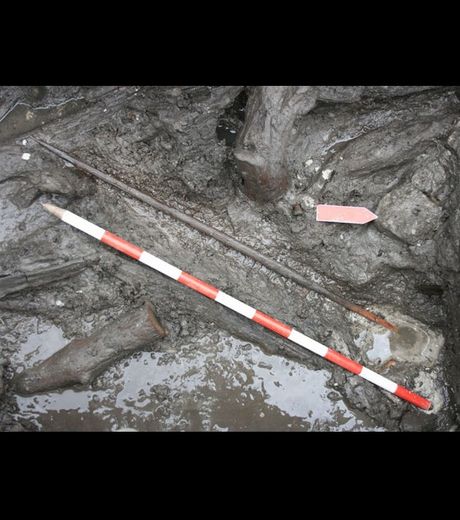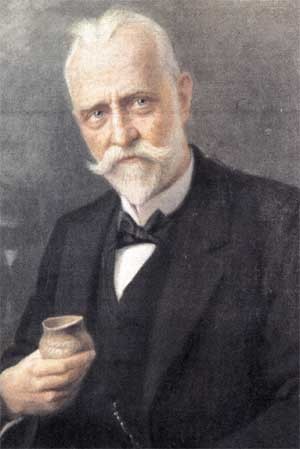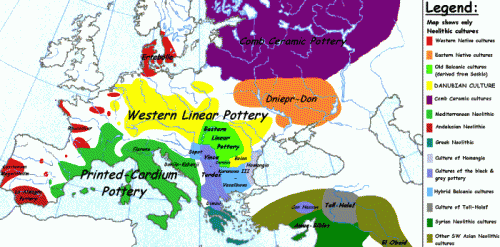 [
[
Avebury Henge, Wiltshire, southwest England
When reading accounts of European prehistory I am often struck by a sense of familiarity—time and again glimmers of the white conquest of North America are awakened.
Continental Europe [2] occupies roughly 3.86 million square miles (10 million square kilometers)—roughly the size of the United States. The retreat of the glaciers after the last Ice Age (10,000 BC) caused the seas to rise as old coastlines flooded permanently for miles inland, former tundra retreated northward, and Europe became covered with trees.
From c. 10,000 BC to 5000 BC, northern Europe was dominated by Mesolithic (post-Ice Age, pre-agricultural) hunter-gatherers (foragers). The Mesolithic (Middle Stone Age) fell between the Paleolithic (Old Stone Age) and the Neolithic (New Stone Age).
By 5500-5000 BC, the earliest Neolithic farmers were expanding through central Europe. It seems likely that these “pioneers” and “frontiersmen” (for such they must essentially have been) displayed character traits and lifestyles similar in many ways to the pioneers and frontiersmen of early North America.
These first farmers cannot automatically be equated with Indo-European invaders, however.
Curiously, prehistorians typically omit any mention of the Indo-European framework from their publications. In reading standard academic accounts it is difficult to understand how the Indo-European narrative [3] fits into European prehistory chronologically, racially, demographically, or linguistically.
For example, according to Microsoft Encarta Encyclopedia, Proto-Indo-European (PIE) was still a unified language around 3000 BC, but by 2000 BC Greek, Hittite, and Sanskrit had each become distinct. (Reconstructed PIE shows that its speakers were agriculturalists—i.e., not hunter-gatherers.)
The problem with such a “recent” dating for PIE is that by 3000 BC Neolithic farmers had been expanding across Europe for at least two to three thousand years, if not more. According to historical demographer Colin McEvedy, quoted below, 3000 BC actually marks the completion of the colonization of Europe by agriculturalists—the very time when PIE speakers were presumably still united in or near their ancestral homeland on the steppes north of the Black Sea.
“Frontier” characteristics of the Early Neolithic in Europe include a probable contest for dominance between indigenous hunter-gatherers and incoming farmers, grievously lop-sided population densities, deforestation, agricultural expansion, and profound cultural transformation accompanying the transition from a hunter-gatherer to an agricultural lifestyle.
The Neolithic Frontier
Around 5000 BC, Germany and the Low Countries were colonized by Early Neolithic farmers belonging to the Linear Pottery Culture [4] (abbr. LBK, Linearbandkeramik)—the first farmers to colonize central and northwestern Europe.
 [5]
[5]
The early Neolithic in Europe. Colors indicate time scales for the spread of farming. "Earliest LBK" (Linear pottery culture) and "Later LBK/AVK" (LBK/Alföld linear pottery culture) represent the first farmers in central Europe.
LBK culture may have been spread by pioneers immigrating along rivers, practicing slash-and-burn agriculture. Their lifestyle was characterized by farming, herding, polished stone axes, timber longhouses, and pottery. The lands into which they moved are believed to have been uninhabited or too sparsely populated by hunter-gatherers to hinder the newcomers’ long-term progress.
As with their adventurous prehistoric and ancient seafaring counterparts, or North American successors, the arrival of settlers (or traders) was likely heralded by initial penetration into a trackless wilderness of river valleys, plains, mountains, and deep forests by dauntless men in quest of adventure and the unknown: explorers, hunters, trappers (is it likely they did not trap?), and scouts interacting with native forager bands and tribes as guests, unofficial diplomats, traders, and foes, sometimes killing and being killed.
After colonizing an area, a new farming population was sedentary up to the capacity of the land, and then the excess population moved to less inhabited areas.
The newcomers not only cultivated grain and kept livestock, but like their American successors supplemented their diet by hunting and fishing for waterfowl, fish, turtles, small mammals, deer, and other wild resources, as revealed in archaeological excavations of refuse pits.
As might be expected, Mesolithic hunter-gatherer sites lacked the large, deep pits from which clay was extracted by settlers for construction and other purposes. Instead, there were small pits, postholes, and scattered, low-density distributions of refuse containing numerous shards of broken pottery, unlike the dense, concentrated Neolithic-style rubbish deposits. Gradually, the Mesolithic way of life became marginalized and disappeared.
In northeastern Belgium, fortified frontier villages marked early Neolithic culture. Individual LBK villages were united together against the foragers beyond. Archaeological remains show that one such Neolithic village was fortified after having first been burnt.
Settlers evidently received a hostile reception from the indigenous, low-density Mesolithic hunter-gatherer populations on the frontier.
In War Before Civilization [6] (1996), American archaeologist Lawrence Keeley notes that prehistorians tend to assume that all foreign goods found at archaeological sites are present because of trade.
When exotic goods are found at a site, they are almost invariably interpreted as being evidence of prehistoric exchange. That such items might be the spoils of war seldom occurs to prehistorians, who immediately proceed to plot “trade routes” and try to reconstruct the mechanisms of exchange. . . . [A]rchaeologists should at least consider the possibility that they represent plunder. (p. 126)
The author acknowledges the problem of proof: “Given the aversion of modern archaeology to the idea of migration and colonization (let alone conquest), the problem of documenting such processes in prehistory is difficult.” This is because defeat or forced migration is typically manifested in the archaeological record only by the peaceful existence of winners on territory formerly occupied by the losers.
Keeley cites the example of the defeat of the Celtic Boii in Bohemia by the Germanic Marcomanni, recorded by Roman historians: “Archaeologically, this [known] event is evidenced only by the expansion of Germanic settlements and cemeteries into regions previously inhabited by Celts” (p. 111). In the absence of Roman written records, this conquest would have remained archaeologically “invisible.”
Deforestation
Mixed and broadleaf forests once dominated all of central Europe, including the British Isles and part of the Russian plains. But, as with the frontier US, they were felled to create plots to grow produce, obtain material for the construction of homes and other structures, and for use as heat and fuel. Only a small portion of this area still has forest cover.
Michael Williams, an English geographer, has outlined the process of deforestation in Neolithic Europe. (“Dark Ages and Dark Areas: Global Deforestation in the Deep Past,” [7] Journal of Historical Geography, 26 [2000]: 28–46)
The older paradigm, he says, viewed indigenous hunter-gatherer Mesolithic cultures from c. 8000–5000 BC “as the primitive fagend of the Palaeolithic.” The Mesolithic populations were engulfed by successive waves of Neolithic proto-agriculturalists sweeping across central Europe from the Near East in a great colonizing wave. The Neolithic colonizers were “primitive” farmers practicing slash-and-burn methods.
In line with this view, Williams quotes English archaeologist Grahame Clark’s assertion in Prehistoric Europe (1952) that the earliest farmers did not initiate
systematic, permanent clearance and the formation of settled fields. Their approach was tentative and their agriculture extensive. Patches of forest would have been cleared, sown, cropped, and after a season or two allowed to revert to the wild, while the farmers took in a new tract.
But Williams, relying upon more recent research, maintains that the truth “is much more complex, and has profound implications for our understanding of forest clearing.” Large sections of forest were cleared with flint and stone axes, demonstrated by modern experiments to have been capable of felling trees. Burning and animal grazing thinned and ultimately eliminated additional woodland.
Neolithic settlement and agriculture were also more stable and permanent than previously thought:
The significance of the timbered long houses found throughout Europe has been ignored yet archaeological excavations during the 1970s showed that some had been occupied for many hundreds of years which makes the universal slash-and-burn hypothesis unlikely. . . . Trees were chopped down by flint and polished stone axes and the flood plains were used for intensive garden cultivation and meadows. Neolithic settlements would have been entirely recognizable to the modern European farming eye.
Williams cites a simulation (model) from Gregg, Foragers and Farmers: Population Interaction and Agricultural Expansion in Prehistoric Europe (1988), conjecturing the type of farming and nutritional strategies necessary to maintain a hypothetical six-household, 30-person village in central Europe. It would have required a little over 6 km2 of woodland to survive—”a staggering 20 hectares [49.4 acres] per person.”
Continuity or Replacement?
The ancestry of contemporary white Europeans is debated by geneticists, archaeologists, and anthropologists. A crucial question is the extent to which Europeans are descended from the first European farmers in the Neolithic Age 7500 years ago, or from Paleolithic hunter-gatherers who were present in Europe since 40,000 years ago. In other words, were the early farmers newcomers from afar, or descendants of indigenous hunter-gatherers who transitioned to farming?
Intuitively, it would seem that the demographically vibrant newcomers must have had significantly higher fertility rates than Mesolithic hunter-gatherers, and therefore contributed more to the modern European gene pool than forager populations.
To provide a rough indication of relative Mesolithic (hunter-gatherer) and Neolithic (early farmer) population densities, I quote Colin McEvedy’s and Richard Jones’s historical estimates for Europe as a whole:
The first Europeans, the hunters of the Old Stone Age, never amounted to more than 100,000 at the best of times; at the worst—specifically during the cold phases of the last Ice Age—there were considerably fewer than that. The ending of the Ice Age offered the chance of escape from this depressing pattern: during the better weather of the following mesolithic period (10th–8th millennia BC) numbers rose past the previous best, finally inching up to the quarter million mark [250,000 people]. Then came the great leap forward, the neolithic revolution of the 5th milliennium. This carried the total over [one] million. It also created the first important distinction between styles of settlement, for, whereas the food-gatherers of the Old Stone Age had rarely achieved densities as high as 0.1 km2, the New Stone Age food-producers ordinarily lived at densities of 1 per km2. By the time these agriculturalists had completed their colonization of southern and western Europe—say by 3000 BC—the continent’s population was more than 2 million. (Atlas of World Population History, Penguin, 1978, p. 19)
One can immediately see a parallel here with North America: in terms of population density and mode of existence, the Neolithic farmers of Europe look a lot like the white pioneers in America, and the old Mesolithic hunter-gatherers like the Indians—albeit with human differences that were presumably more ethnic than racial in character.
According to Colin McEvedy, “The density of a Neolithic people being greater than that of a mesolithic one by a factor of at least ten, the ethnic contribution of the aborigines—even if they were absorbed rather than exterminated or expelled—must have been insignificant” (The Penguin Atlas of Ancient History, 1967, 9).
English archaeologist Sir Paul Mellars offers a similar hypothesis for the previous displacement of Neanderthals in Europe by anatomically modern humans (a.m.h.—they are no longer called Cro-Magnons):
[A] simple imbalance in relative birth-over-death ratios between the two populations could quite easily have led to a process of effective replacement of one population by the other, within a relatively short space of time—perhaps no more than a thousand years or so. If we envisage Neanderthal populations who were fairly thinly distributed over most areas of Europe, in relatively small, highly mobile social units, one could easily visualize a scenario of eventual population replacement without any notion of mass genocide, or even direct conflict between the two populations. (“The Upper Paleolithic Revolution” in Barry Cunliffe, ed., The Oxford Illustrated Prehistory of Europe, Oxford University Press, 1994, pp. 42–78 at 57)
It is easy to imagine a comparable dynamic at work at the time of the Mesolithic-Neolithic transition. Indeed, the same process is decimating the white population today [8].
While the notion of “mass genocide” is a red herring (in the Neanderthal context it is championed by anti-European Jewish popularizer Jared Diamond), the familiar trope of no direct conflict at all has been persuasively refuted by archaeologist Lawrence Keeley.
A 2009 study comparing mitochondrial DNA (mtDNA) sequences (a useful but restricted form of genetic analysis) from late European hunter-gatherer skeletons with those from early farmers and from modern Europeans found that
Most (82%) of the ancient hunter-gatherers share mtDNA types that are relatively rare in central Europeans today. Together, these analyses provide persuasive evidence that the first farmers were not the descendants of local hunter-gatherers but immigrated into central Europe at the onset of the Neolithic. (Bramanti, et. al, “Genetic Discontinuity Between Local Hunter-Gatherers and Central Europe’s First Farmers,” [9] Science [October 2, 2009]: 137–140)
The authors add, “We find large genetic differences between all three groups that cannot be explained by population continuity alone.”
Against this view it is maintained by others that hunter-gatherers may have adopted agricultural techniques and, transitioning to primitive farming, expanded the indigenous gene pool, thereby preserving Paleolithic continuity:
At the more general level, it is possible to claim there has been a major shift in opinion on the ancestry of Europeans, driven largely by the combined forces of archaeology and genetics. Near Eastern farmers played their part, but the majority of European [mtDNA and Y-chromosome] genetic lineages have their roots in the European Paleolithic. (Martin Richards, “The Neolithic Invasion of Europe,” [10] Annual Review of Anthropology, October 2003 32:135–162 at 157)
For now, the evidence for either population replacement or Paleolithic continuity remains equivocal. Nevertheless, published accounts suggest key ways in which the spread of farming through Europe along an advancing frontier during the Neolithic demographic transition resembled the white settlement of North America millennia later (1500s–1800s).
Quite possibly the enterprising men and women of the early Neolithic were more similar to our own storied frontiersmen and pioneers than is generally recognized.





 del.icio.us
del.icio.us
 Digg
Digg


 The term “culture” entered archaeology through 19th century German ethnography, where the Kultur of tribal groups and rural peasants was distinguished from the Zivilisation of urbanized peoples. Kultur was used by German ethnologists to designate the distinctive ways of life of a particular people or Volk.
The term “culture” entered archaeology through 19th century German ethnography, where the Kultur of tribal groups and rural peasants was distinguished from the Zivilisation of urbanized peoples. Kultur was used by German ethnologists to designate the distinctive ways of life of a particular people or Volk.